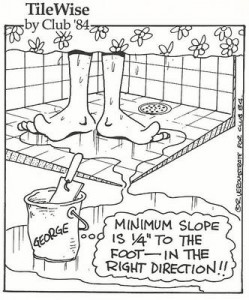Tile Tips
To Slope or Not to Slope
 Water damage in construction is a huge problem and can add up to millions of dollars in repairs. Much of that cost is due to collateral damages caused by a construction defect. One common defect in tile and stone installations is the lack of slope in wet areas such as showers, exterior decks and balconies. Water needs to be managed in these applications by using waterproof membranes. Water should be directed to drains and away from moisture sensitive materials. Not only is the surface slope to drain of a tile or stone assembly important, but the underlying slope to drain is just as important, if not more so. Water that penetrates the tile and porous grout travels beneath the tile, and if that water isn’t directed to a drain that properly drains it away, it can result in many types of moisture damages particularly with stone applications. If water becomes stored under the tile due to lack of slope or plugged drain weep holes, then the tile can be subjected to excessive moisture conditions that may never completely dry. As the stored moisture migrates through the concrete, tile and grout, it picks up minerals (salts) that dissolve into the moisture and travels with it. As the moisture reaches the surface it evaporates and those minerals solidify (crystallize) and expand, and the result can be a condition called “spalling” (deterioration of the surface) and staining. The key message here is make sure the tile assembly is sloped to drain at the surface and at the subsurface. Plus make sure there is a waterproof membrane under the tile and stone assembly to direct the water to drains. Follow the industry standards per ANSI A108 and TCNA Handbook.
Water damage in construction is a huge problem and can add up to millions of dollars in repairs. Much of that cost is due to collateral damages caused by a construction defect. One common defect in tile and stone installations is the lack of slope in wet areas such as showers, exterior decks and balconies. Water needs to be managed in these applications by using waterproof membranes. Water should be directed to drains and away from moisture sensitive materials. Not only is the surface slope to drain of a tile or stone assembly important, but the underlying slope to drain is just as important, if not more so. Water that penetrates the tile and porous grout travels beneath the tile, and if that water isn’t directed to a drain that properly drains it away, it can result in many types of moisture damages particularly with stone applications. If water becomes stored under the tile due to lack of slope or plugged drain weep holes, then the tile can be subjected to excessive moisture conditions that may never completely dry. As the stored moisture migrates through the concrete, tile and grout, it picks up minerals (salts) that dissolve into the moisture and travels with it. As the moisture reaches the surface it evaporates and those minerals solidify (crystallize) and expand, and the result can be a condition called “spalling” (deterioration of the surface) and staining. The key message here is make sure the tile assembly is sloped to drain at the surface and at the subsurface. Plus make sure there is a waterproof membrane under the tile and stone assembly to direct the water to drains. Follow the industry standards per ANSI A108 and TCNA Handbook.
